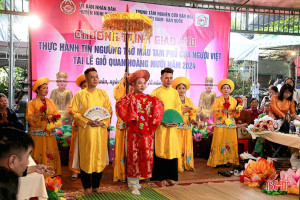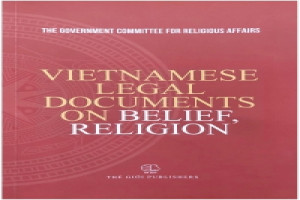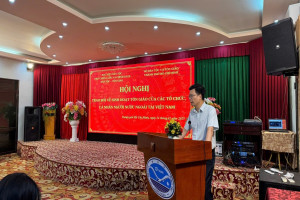Western missionaries started their work in Vietnam as early as the beginning of sixteenth century.
Khâm định Việt sử Thông giám Cương mục (Royal Vietnamese synopsis of general history) notes that “In the year of Nguyên Hòa under King Lê Trang Tôn (1533), a businessman named Ignatius arrived via sea and evangelized in Ninh Cuờng Village of Quần Anh Commune, Nam Chấn District and in Trà Lũ Village of Giao Thủy District(both now part of Nam Định province in Northern Vietnam)". Many scholars studying the history of Catholicism list 1533 as the beginning of Catholic missionary work in Vietnam. Later on, in 1550, Father Gaspar da Santa Cruz preached in Hà Tiên province (now part of modern-day Kiên Giang province in Southern Vietnam); in 1558, other priests including Luís de Fonseca and Grégoire de la Motte evangelized in the country’s Central region; in 1583, Fathers Diego Doropesa and Pedro Ortiz evangelized in the coastal area of Quảng Ninh province in Northern Vietnam. Between 1533 and 1614, most of the missionaries came from the Portuguese Order of Friars Minor and the Spanish Order of Preachers; they traveled on merchant ships. However, their mission was not fully successful due to language barriers and their unfamiliarity with Vietnam’s terrain. From 1615 to 1665, missionaries of the Portuguese Society of Jesus based in Macau (China) came to Vietnam and operated in both Đàng Trong (South of the Gianh River in modern-day Quảng Bình province) and Đàng Ngoài (North of the Gianh River). Priests working in Đàng Trong included Francesco Buzomi, Diego Carvalho, Francisco de Pina, and Alexandre de Rhodes (known as Father Đắc Lộ). Priests working in Đàng Ngoài included Pedro Marques, Gaspar d’Amaral, Antonio Barbosa, etc.
In particular, Father Alexandre de Rhodes managed to create a Latin-based writing system, which contributed to the development of current Vietnamese writing and effectively served Catholic missionary work. According to statistics from the Catholic Church, missionaries of the Society of Jesus were able to attract 100,000 religious followers after 37 years of evangelization in Đàng Ngoài with 25 priests and five assistants and after 50 years in Đàng Trong with 39 priests and one assistant. By 1850, there were 500,000 Catholic followers and 227 priests in the whole country (380,000 followers and 147 priests in Đàng Ngoài and 120,000 followers and 80 priests in Đàng Trong).
The first half of the nineteenth century saw important changes in terms of organization: In 1844, Pope Gregory XVI divided the Đàng Trong Diocese into West Đàng Trong (Sài Gòn), which comprised six Southern Vietnamese provinces and Cambodia and was overseen by Bishop D. Lefèbvre Ngãi, and East Đàng Trong (Qui Nhơn) overseen by Bishop E.T. Cuénot Thể. Similarly, in 1846, the Pope divided West Đàng Ngoài into West Đàng Ngoài (Hà Nội) under Bishop P.A. Retord Liêu and South Đàng Ngoài (Vinh) under Bishop J.D. Ganthier Hậu. In 1848, the Pope in turn divided East Đàng Ngoài into East Đàng Ngoài and Central Đàng Ngoài (Bùi Chu). In 1850, the Pope split East Đàng Trong into North Đàng Trong (including part of Quảng Bình, Quảng Trị, and Thừa Thiên Huế provinces) under Bishop F. M. Pellerin Phan and East Đàng Trong (from Đà Nẵng to Qui Nhơn, Phan Thiết). West Đàng Trong was split into Nam Vang (including Cambodia and Vietnamese provinces South of Hậu Giang) under management by Bishop J.C. Miche Mịch and into West Đàng Trong (from Đồng Nai to Vĩnh Long provinces) under Bishop D. Lefèbvre Ngãi.
Along with enhanced missionary work, not a few missionaries from the Société des Missions Étrangères de Paris (Paris Society for Overseas Missions) involved themselves in non-religious activities, attracting a group of Catholic followers and clerics to assist French schemes to invade and dominate Vietnam.
The development of Catholicism in this period is reflected in the following statistics:
In 1890, eight dioceses had 648,435 Catholic followers, 9 bishops, 575 priests and clerics (of which 356 were Vietnamese), and 930 churches. By 1910, those figures had increased to 900,000 followers; by 1939, the figures had further increased to 1,544,765 followers, 1,662 priests and clerics (of which 1,343 were Vietnamese), and 979 parishes.
By 1913 there were 11 dioceses and one archbishop’s office in Vietnam. To support the Vietnamese Catholic Church, in 1925, the Vatican established the Indochina Resident Governor’s Office, which was based in Phú Cam (Huế).
For the first time, in 1933 (400 years after the introduction of Catholicism to Vietnam), the Vatican ordained a Vietnamese bishop: Nguyễn Bá Tòng. (By 1975, 41 Vietnamese bishops had been ordained; the figure for the period between 30 April 1975 and December 2008 is 55, of which 4 were cardinals). Peace was re-established in the North in 1954, on 24 November 1960, Pope John XXIII issued Ordinance on the establishment of Vietnamese Catholic titles; at the same time, he upgraded all bishops’ offices in the then 20 dioceses from “quasi-offices” to “authentic offices". Between 1954 and 1975, some dioceses in the Center and the South of the country were established or divided to facilitate the management of followers, thus increasing the number of dioceses to 25. In December 2005, Xuân Lộc Diocese (Đồng Nai province in Southern Vietnam) was split into two: Xuân Lộc (Đồng Nai province) and Bà Rịa (Bà Rịa - Vũng Tàu province). At present, the Vietnamese Catholic Church has 26 dioceses across the country.
During the process of evangelization and church development in Vietnam, Catholicism contributed to the enrichment of Vietnamese culture: with the distinctive architectural designs of its churches, particularly the stone church in Phát Diệm (Kim Sơn District, Ninh Bình province), the Hà Nội Cathedral; festivals, such as Noel and the La Vang Festival in Quảng Trị province in Central Vietnam, display the country’s fine cultural attributes.
In 1980, the Vietnamese Council of Bishops was established, composed of all the bishops in Vietnam. The Vietnamese Council of Bishops has the duty to “encourage close connections to promote the service to God in apostolic forms and by methods that suit the times, in a spirit of bonding with the nation and the country". (Vietnam Catholic Church Yearbook – 2004). A letter by the Vietnamese Council of Bishops in 1980 identified the working orientation of the Vietnamese Catholic Church as “Living the Gospel within the nation for the happiness of fellow Vietnamese".
The Executive Committee of the Vietnamese Council of Bishops includes: A chairman, vice-chairmen, secretary general, deputy secretaries general, and heads of the council’s commissions. The Council for the ninth term (2004-2007) has nine bishops’ commissions: Teachings and Beliefs; Worship and Holy Arts; Holy Music, Priests and Postulants; Clergymen; Parishioners; Evangelization; Culture; and Social Charity.
A term for the Council of Bishops lasts three years. Since the Council’s foundation, there have been nine terms: The first from 1980 to 1983; the second from 1983 to 1986; the third from 1986 to 1989; the fourth from 1989 to 1992; the fifth from 1992 to 1995; the sixth from 1995 to 1998; the seventh from 1998 to 2001; the eighth from 2001 to 2004; and the ninth from 2004 to 2007.





